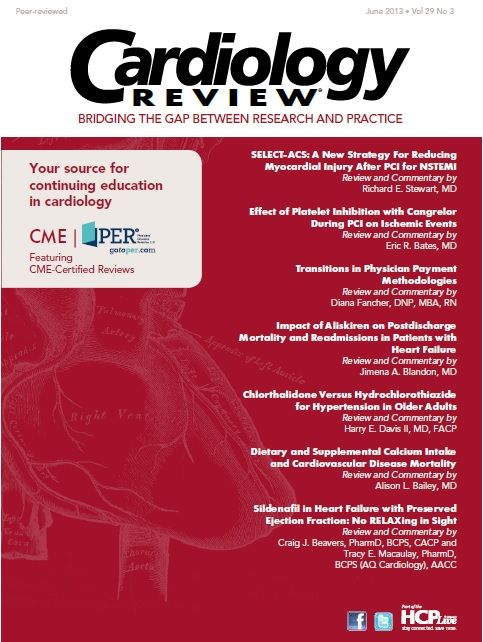Publication
Article
Cardiology Review® Online
Do Reduced Resident Hours Improve Outcomes?
In this department of Cardiology Review we ask several clinicians to answer a question of current interest to health care practitioners. We asked three Cardiology Review editorial board members to comment on the study by Desai et al, “Effect of the 2011 vs 2003 Duty Hour Regulation- Compliant Models on Sleep Duration, Trainee Education, and Continuity of Patient Care Among Internal Medicine House Staff,” JAMA Intern Med, published online March 25, 2013. Please send your comments or suggestions for future questions to Dr. Mukherjee at debabrata. mukherjee@ttuhsc.edu. Space permitting, we will post them online and in the iPad edition of the next issue.
Q: Do reduced resident hours improve outcomes?

Carol L. Chen, MD
Director, Cardiac Intermediate Care Unit
Memorial Sloan- Kettering Cancer Center
New York, NY
A: The primary goal of residency training is to transform medical students into independent, capable physicians in their chosen field within a reasonable training period. A notion made popular by Malcolm Gladwell’s bestseller, Outliers, is that 10,000 hours of practice is integral to becoming expert at any particular endeavor.1 Based on the current ACGME guidelines of an 80-hour workweek limit in a 48-week year, residents would log in a maximum 3,840 hours per year. Over 3 years (the minimal residency), a house officer would log in more than 10,000 hours, certainly sufficient hours. However, the 2011 duty-hour regulations go beyond limiting resident work hours. The crossover study by Desai et al of The Johns Hopkins Medical School’s internal medicine residency program sheds light on the possible unintended consequences of the stricter 2011 regulations.2
Many studies have confirmed that duty-hour limitations have decreased house staff fatigue and increased sleep, but a commensurate decrease in medical errors has not clearly been demonstrated.3-5 The effect of the ACGME rules on the quality of resident education has been studied by many groups by using surrogate markers such as patient volume, examination scores, board exams, and surveys, with mixed conclusions. A big difference between the 2003 and 2011 duty hours regulation is the 16-hour limit on continuous duty hours for interns. Not all hours are equal in teaching value. However, to comply with this rule, many training programs have instituted a night-float system and later start times for on-call days. As a consequence, these residents have less contact with attendings in a teaching environment, and they care for fewer patients. Thus, they may lose opportunities for discussion and timely feedback about their clinical decisions. This is a real, but difficult-toquantify, loss.
Desai’s study demonstrated that more patients were admitted and primarily cared for by the interns in the control group (compliant with the 2003 duty hours regulations) compared with both experimental groups (compliant with 2011 guidelines).2 The study also showed a 25% decrease in attendance at educational conferences by the house staff in the experimental groups. Training programs should continue to innovate schedules and formats to promote didactic sessions. The Mayo Clinic piloted a small but significant change in the time and format of the daily medical intensive care didactic session in order to comply with work-hour regulations, with good outcomes.6
Desai’s study also showed that the number of handoffs increased by 130% to 200% in the 2011 on-call models compared with the 2003 model. This consequence cannot be understated. Even prior to 2011, several studies demonstrated serious issues associated with house staff communication in passing responsibility after the 2003 regulations took place. In 1 small study utilizing house staff interviews regarding real-time handoffs, although the house staff rated their colleagues’ communication quality as high, in 60% of cases the most important piece of clinical information about a patient was not successfully communicated.7 A prospective study using recordings of 2 weeks of house staff sign-out at Yale demonstrated 7.5 sign-out-related problems per 100 patient-days, which resulted in near misses, medical errors, and delay in treatment.8 The authors acknowledged that this was likely an underestimation. The relationship and trust with the patient and family is very difficult to build as physicians hand off from one another and often appear not to communicate well.
Desai and colleagues were able to complete their study comparing different on-call models because it was done before the new rules took effect (July 1, 2011). Any further studies of this sort are no longer possible. The Next Accreditation System (NAS) as proposed by the ACGME9 has many lofty goals that emphasize innovation to improve education; however, changes will be restricted by the limited permutations within a rigid duty-hour grid with a finite number of workers. Hospitals have coped with many of these regulations by hiring more physician extenders to take the place of house staff. In the current economic climate of cutbacks, this may not be a viable option for many hospitals. Resident duty hours should be limited to avoid overwork; however, I agree strongly with Rosenbaum and Lamas’s proposal that the ACGME should allow exemptions for further research in this field in order to truly understand this complex matter.10
References
1. Gladwell M. Outliers: the story of success. New York, NY: Little, Brown and Co; 2008.
2. Desai SV, Feldman L, Brown L, et al. Effect of the 2011 vs 2003 duty hour regulation-compliant models on sleep duration, trainee education, and continuity of patient care among internal medicine house staff: a randomized trial. JAMA Intern Med. 2013:1-7.
3. Volpp KG, Rosen AK, Rosenbaum PR, et al. Mortality among hospitalized Medicare beneficiaries in the first 2 years following ACGME resident duty-hour reform. JAMA. 2007;298:975-983.
4. Fletcher KE, Reed DA, Arora VM. Patient safety, resident education and resident well-being following implementation of the 2003 ACGME duty hour rules. J Gen Intern Med. 2011;26:907-919.
5. Howard DL, Silber JH, Jobes DR. Do regulations limiting residents’ work hours affect patient mortality? J Gen Intern Med. 2004;1:1-7
6. Lim KG, Dunn WF, Klarich KW, et al. Internal medicine resident education in the medical intensive care unit: the impact on education and patient care of a scheduling change for didactic sessions. Crit Care Med. 2005;33:1534-1537.
7. Chang VY, Arora VM, Lev-Ari S, et al. Interns overestimate the effectiveness of their hand-off communication. Pediatrics. 2010;125:491-496.
8. Horwitz LI, Moin T, Krumholz HM, et al. Consequences of inadequate sign-out for patient care. Arch Intern Med. 2008;168:1755-1760.
9. Nasca TJ, Philibert I, Brigham T, et al. The next GME accreditation system--rationale and benefits. New Engl J Med. 2012;366:1051-1056.
10. Rosenbaum L, Lamas D. Residents’ duty hours-toward an empirical narrative. New Engl J Med. 2012;367 (21):2044-2049.

Karla K. Quevedo, MD
Cardiology Fellow
Texas Tech University Health Sciences Center
El Paso, TX
A: Long hours are an obligatory component of medical education and preparation for a profession that demands hard work and dedication. The formal study of the effect of residents’ duty hours began in 1971, when a study showed post-call residents made more errors in reading a standardized electrocardiogram than their rested colleagues.1 In 1984, the death of college student Libby Zion in a New York teaching hospital initiated a debate about resident hours and appropriate supervision.2 In response to interest in duty-hour limits prompted by the death of Ms Zion, in June 1987 the Accreditation Council of Graduate Medical Education (ACGME) authorized the formation of a Task Force on Resident Hours and Supervision. In March 1988, the Association of American Medical Colleges (AAMC) for the first time released its position on resident hours,3 which specified that hours should not exceed 80 per week, averaged over 4 weeks. ACGME granted preliminary approval to common duty-hour limits that became effective in July 2003. ACGME subsequently made more modifications to the 2003 regulations, which were implemented in 2011. The main difference between the 2 latest models is that the 2003 model contemplates shifts every fourth night and overnight call with 30-hour duty limits; the 2011 model contemplates shifts every fifth night and overnight call or a night-float schedule of 6 consecutive nights, both with 16-hour duty limits.
While some studies of the effect of duty-hour regulations in New York State reported improved patient care, a larger number of studies also found fragmentation and reduced continuity, reduced quality of care, and higher rates of complications.4,5 Despite large sample sizes, studies of the effect of the common duty-hour limits at the national level found little change in patient mortality during the 2 years following the implementation of the 2003 ACGME duty hours.6,7 The recent report from the randomized trial by Desai et al showed that compared with a 2003-compliant model, the 2011 duty-hour regulation— compliant model was associated with increased sleep duration during the on-call period, but with deteriorations in educational opportunities, continuity of patient care, and perceived quality of care.
On average, interns in the 2003 model slept 3 hours less across 48-hour on-call periods compared with interns in the 2011 model. Earlier research using military personnel and volunteers had shown that sleep deprivation affected performance across a range of dimensions including vigilance, cognition, and executive function.8,9 Different meta-analyses showed that sleep deprivation negatively influenced performance in controlled experiments and in clinical studies involving residents.10,11 The meta-analyses also explore moderators in the effect of sleep loss on performance, including type of performance, as well as task duration and complexity. Research studies in this area also showed that vigilance appears to be affected first by sleep loss, to a higher degree than memory and cognitive function, with gross motor performance being quite resilient.12 Considering these data, we can conclude that interns in the 2011 model slept more, so they had better performance and were more vigilant at work.
Interns in the 2003 model admitted a higher proportion of patients and more patients were primarily cared for by the interns compared with the 2011 model. It is possible that in the 2003 model, interns admitted fewer patients compared with the 2011 model due to fewer working hours; however, the complexity of patients’ health problems today is greater than in 2003, mainly because health insurers are pushing for shorter hospital stays, and only the sickest patients remain hospitalized. It is also important to mention that although it was not statistically different with respect to the operations outcomes, residents in the 2011 model were more effectively discharging patients in the morning, and the number of readmissions was lower compared with the 2003 model.
Opportunities to attend an educational daily noon conference were reduced by 25% in the 2011 model due to decreased working hours between 8 am and 6 pm. Resident education is influenced by multiple factors. No single intervention, including limits on resident hours, can ensure that the interns will have better or worse education. A more objective parameter can be used to evaluate residents’ education, such as in-training scores or passing rates on internal medicine board exams.
The minimal number of handoffs between interns greatly increased in the 2011 model. The minimal number of different interns caring for a patient during a 3-day stay increased in the 2011 model. I do agree that this could represent a risk in patient safety due to the possibility that each transition creates the potential for information to be lost or distorted. In 2006 the Joint Commission added transitions in patient care to its National Patient Safety Goals, referencing the need for a “standardized approach to hand-off communication, including an opportunity to ask and respond to questions.”12 A study of closed malpractice claims attributed a high percentage of errors in teaching settings to teamwork problems, with handoff error being disproportionally more common in teaching settings.13 Programs must design clinical assignments to minimize the number of transitions in patient care and institutionalize structured handover processes to ensure the continuity of care and patient safety.
Trainee satisfaction was higher in the control model compared with either 2011 model, including perceived quality of care and team membership, assessed using a collection of questions focused on teamwork and perceptions of being a central member of the team. It is important to keep in mind that residency is a process that is an essential transformation of the medical student to the independent practitioner role; it is physically, emotionally, and intellectually demanding, and requires a great deal of effort on the part of the residents. When I was a recently graduated medical intern, I didn’t feel that I was ready to be a central team member. In my view, it is therefore unfair to ask interns, as the Desai et al study did, how satisfied they were when they had only just started the process of becoming an integral member of the medical team. In addition, it would be very important to ask patients about this issue; after all, patient satisfaction is part of quality of care.
The main objective of the 2011 duty-hour regulations is to be flexible and facilitate the education of residents who must be prepared to enter the unsupervised and competitive practice of medicine at the completion of their training. Although the 2011 duty-hour model is not perfect, the Desai et al study has not shown that it is ineffective or worse than the 2003 model. Changes can continue to be made in order to improve the professional development and education of residents and fellows and make the model better.
References
1. Friedman RC, Bigger JT, Kornfeld DS. The intern and sleep loss. N Engl J Med. 1971;285:201-203.
2. Lermer BH. A case that shook medicine: how one man’s rage over his daughter’s death sped reform of doctor training. Washington Post. November 28, 2006. http://www. washingtonpost.com/wp-dyn/content/article/2006/11/24/ AR2006112400985.
3. Petersdorf RG, Bentley J. Resident hours and supervision. Acad Med. 1989;64:175-181.
4. Howard DL, Silber JH, Jobes DR. Do regulations limiting residents’ work hours affect patient mortality? J Gen Intern Med. 2004;1:1-7
5. Laine C, Goldman L, Soukup JR, Hayes JG. The impact of a regulation restricting medical house staff working hours on the quality of patient care. JAMA. 1993;269:374- 378.
6. Volpp KG, Rosen AK, Rosenbaum PR, et al. Mortality among hospitalized Medicare beneficiaries in the first 2 years following ACGME resident duty-hour reform. JAMA. 2007;298:975-983.
7. Press MJ, Silber JH, Rosen AK, et al. The impact of resident duty hour reform on hospital readmission rates among Medicare beneficiaries. J Gen Intern Med. 2011;26:405- 411.
8. Laughlin HP. Research in sleep deprivation and exhaustion: an invitation to further observation and study. Int Rec Med Gen Pract Clin. 1953;166:305-310.
9. Wilkinson RT. Interaction of lack of sleep with knowledge of results, repeated testing, and individual differences. J Exp Psych. 1961;62:263-271.
10. Samkoff JS, Jacques CHM. A review of studies concerning effects of sleep-deprivation and fatigue on residents’ performance. Acad Med. 1991;66:687-693.
11. Philibert I. Sleep loss and performance in residents and nonphysicians: a meta-analytic examination. Sleep. 2005;28:1392-1402.
12. Arora V, Johnson J. A model for building a standardized hand-off protocol. Joint Comm J Qual Patient Safety. 2006;32:646-655.
13. Singh H, Thomas EJ, Petersen LA, Studdert DM. Medical errors involving trainees: a study of closed malpractice claims from 5 insurers. Arch Intern Med. 2007;167:2030- 2036.

Rabab Mohsin, MD
Cardiology Fellow
Texas Tech University Health Sciences Center
El Paso, TX
A: “When I was an intern…” “When I was a resident…” and “Back when I was a fellow…” are all nostalgic statements made by supervising physicians to young physicians during their postgraduate training. That tradition has not changed. But it is interesting to observe how medical and surgical clinical training in the United States has its own history of changes born largely of trial and error over the past 30 years.
In 1974, under the pseudonym of Samuel Shem, a psychiatrist wrote a satirical novel turned cult phenomenon that depicted the psychological warfare medical interns endured in the 1970s, when there really were no regulations governing physician training. In a New York Times article in August 2009, journalist Howard Markel did a series of interviews of characters from the same novel, titled House of God, after the Accreditation Council for Graduate Medical Education (ACGME) instituted duty-hour rule changes in 2003 and 2008. In the article, Markel notes that the novel “helped initiate a dialogue on the effects of sleepless medical training.”1 In 2011 the ACGME again changed duty-hour rules because of incidents involving medical trainees that were publicized by the news media, as well as larger cultural changes occurring in the United States.
In a recent study by Desai et al, published in JAMA Internal Medicine,2 the authors created a crossover, survey-based design protocol in an academic research setting. The study design consisted of multiple teams of medical residents, including interns in the latter part of their first year and senior residents, at John Hopkins Hospital. There were 2 control models that followed ACGME 2003 duty-hour regulations and 2 experimental models following 2011 regulations. The 2003 duty hour changes were mostly intended to improve resident well-being, patient safety, and health care. The 2003 regulations for duty-hours were limited to a 30-hour continuous period and a mandatory 80-hour workweek went into effect. The 2011 duty hours expanded on the previous regulations by having mandatory resting periods between shifts, increased supervision, and a 16-hour limit of continuous duty hours for interns or first-year trainees.
The primary outcome of the study was the effect of 2011 duty-hour and supervision changes on sleep duration during the on-call period. Secondary outcomes were trainee education, continuity of patient care, sleep-duration outside of the on-call period, and intern/nurse satisfaction. Desai et al found that the 2011 duty-hour changes are associated with worse outcomes for both educational opportunities and continuity of care. Even though sleep duration increased with the 2011 changes, the reduction of satisfaction concerning education, competency of trainees, and continuity of patient care exposed gaps with the new duty-hour regulations, according to this study. Increased numbers of handoffs made communication and continuity of care more difficult. The night-float experimental model reduced opportunities to attend educational conferences and bedside rounds because clinical faculty conventionally does morning teaching sessions.2
There is a paradox with new technologies and the advances in the medical field that affect recent medical school graduates entering postgraduate training in teaching hospitals. Trainees have more complicated cases among their patients, as well as access to complex diagnostic and therapeutic tools 24/7. Complicated patients and readily accessible diagnostic tools demand more critical thinking and application of knowledge for effective patient care and safety.
Today a patient’s life expectancy has improved because of a greater understanding of the importance of preventive health measures, as well as new therapies for various diseases, compared with the 1970s. For those of us who have completed training, it is easy to look back and see how the weakness and strengths of our training programs affected us in our own growth as faculty. The authors of the Desai et al survey-based study have concluded that the rigidity of the 2011 duty-hour regulations have more of a negative impact than was intended by the ACGME.
The study did have some limitations that are important to note. First, all teaching programs are not created equal. Second, patient populations differ throughout the nation, and teaching cultures vary in a multitude of ways: faculty interest and experience, ancillary staff availability and dedication, patient population, and financial state of the teaching hospital. Thus, it is difficult to replicate studies such as that of Desai et al. However, we can acknowledge a pattern seen in this study: there is an impact when trainees get less hands-on experience. This is felt by interns/residents and faculty alike. If interns are able to see only 5 patients rather than 10 or 20 during a typical shift, there will be gaps in the overall educational experience and less confidence in the clinical application of this experience.
Medical knowledge is first gained in medical school, continuing to solidify on a daily basis through our training. However, during the years of residency the main objective is to gain practical experience and provide safe and effective patient care. This can only be achieved if the trainees and their mentors repeatedly question whether the overall postgraduate experience has been well rounded and structured to make one a good doctor. On the final day of training, the answer should be a unanimous “Yes.”
References
1. Merkel H. A book doctors can’t close. New York Times. August 17, 2009. http://www.nytimes.com/2009/08/18/ health/18house.html?_r=0.
2. Desai SV, Feldman L, Brown L, et al. Effect of the 2011 vs 2003 duty hour regulation-compliant models on sleep duration, trainee education, and continuity of patient care among internal medicine house staff: a randomized trial. JAMA Intern Med. 2013:1-7.






